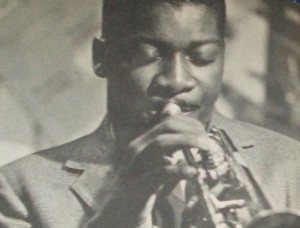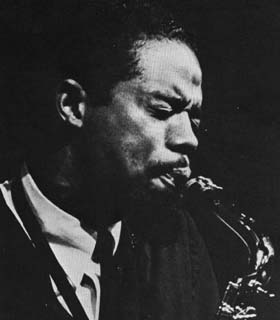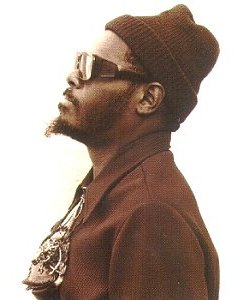HOW TO TALK ABOUT JAZZ MUSIC?
Well, perhaps it’s better to determine how not to talk about jazz music. Hearing is believing. That’s all there is to it. And if you hear something that speaks to you, keep listening. Whatever effort you put in will be immeasurably rewarded. During the decade or so that stretched from my mid-’20s to mid-’30s, I used to have more of an evangelical vibe. It’s not necessarily that I’m less invested now, then I was then; quite the contrary. But, if I wasn’t particularly interested in converting people then (I wasn’t), I’m even less so today. When it comes to art in general and music in particular, entirely too many people are very American in their tastes: they know what they like and they like what they know, which will continue to ensure that what they don’t know won’t ever hurt them. Also, let’s face it, the only thing possibly more annoying than some yahoo proselytizing their religion on your doorstep is some jackass getting in your grill about how evolved or enviable his or her musical tastes happen to be. Life is way too short, for all involved.
Volumes are devoted to the romantic gravity of the suffering artist syndrome—the suicides, the drinking and the desolation; these are the things that people who write about artists tend to write about. Certainly, the artists themselves express this angst in their art, but you seldom hear or see the solipsism on the screen or the stage or in the grooves of the vinyl. But then again, these artists don’t need anyone to celebrate their achievements, because the art they created does so with exceeding adequacy and eloquence. You can’t believe everything you read, but you can always have faith in what you hear; the ears never lie. Not when it comes to music. Not when it comes to jazz music.
For instance, what John Coltrane achieves on the final section of “A Love Supreme” could cause even the most cynical hater of humanity to feel stirred by the uniquely moving and profoundly positive force of musical expression. It’s not possible to remain neutral while listening to Charles Mingus, who, after amyotrophic lateral sclerosis confined the colossus to a wheelchair, was obliged to literally sing his songs, composing them with his mouth when he no longer could lift a pen. Here are three other musicians, all of whom deserve much wider recognition, not just for the astonishing music they made, but the circumstances they rose above to make it.
 Booker Little
Booker Little
For many years—all through college and after graduate school—John Keats signified, for me, the ultimate artistic loss of all time. In terms of talent and potential versus time granted to practice and refine his skills (dead from tuberculosis, aged 25), Keats has even the most unbearable cases beat: his good friend and fellow genius Percy Bysshe Shelley (aged 29), their mutual friend Lord Byron (36). Even the great Franz Schubert (31) who, considering his abilities, may have amassed a body of work to be mentioned in the same breath as his fellow Austrian Mozart (himself only 35). Yet, like Mozart, Schubert was so stunningly prolific the collected output somewhat mitigates the loss.
Once I began seriously listening to jazz music, I came to recognize that this art form is littered with premature deaths. We know all about our famous rock stars, many of whom flamed out early in life due to self-destructive habits and hobbies. The typical, if irresponsible (and racist) assumption is that most jazz players were junkies and therefore each casualty must have died with a needle in their arm. In actuality, the number of luminous young men whose deaths were not self-inflicted is unsettling.
At the top of my list is Booker Little. Considered the heir apparent to the effulgent Clifford Brown (himself only 25 when he died, clean and sober, in a car crash), Little did not die so much as have his life defrauded, at age 23, from uremia—an especially brutal, and painful, type of kidney failure. Barely legal drinking age, Little had already led sessions that stand alongside the best post-bop recordings of the era (He neither drank nor took drugs, incidentally).
Little was able to complete two albums in the final year of his life; both considered masterpieces by aficionados, but largely obscure outside of jazz circles. This is ignominious on a number of levels. For one thing, the music contained in these releases captures the ethereal nature of life, the ecstasy of creation and the unique expressions our most gifted artists are capable of conveying. Beyond that, the albums are touchstones; perhaps the most poignant instances from any era of a human being defying death with dignity and joy, even as mortality circled his head like a demented buzzard.
What Keats was able to convey so succinctly, and enduringly, with words, Little achieves without needing a single syllable. His voice, of course, is his instrument, and his trumpet tells the story of his life: not for nothing was his final work entitled Victory and Sorrow. It’s impossible to listen to this music without hearing the history of illness, injustice and ultimately the transcendent human ability to, at least temporarily, overcome anything.
At once somber and serene, the compositions achieve an intense distillation of Beauty: the joy of inspiration leavened with the contemplation of transience. It is all in there, as devastating in its way as the symphonies of Mahler or the extended meditations of Tolstoy. Does the concentrated intensity of this sound derive from the soul of a man who sensed his time was, all of a sudden, just about up? It is almost intolerable to imagine that he was anticipating –and realizing– some of the experiences and emotions of the years he should have had, putting every thought, feeling, regret and ambition into his playing. Was he in fact dealing with significant pain while he composed and played this music? If so, we are getting into deaf Beethoven levels of drama and disbelief.
How did he manage? There is a tune on the album Out Front entitled “Strength and Sanity”, which could be a commentary on what any individual requires in order to survive—much less thrive—in a world where there is a distinct shortage of both. It certainly speaks to ingredients necessary for jazz musicians, incomparably talented men who were still, circa 1961, considered second-rate citizens, not to mention the additional stigma of being jazz musicians. But it is also a statement about what Little had to count on and cultivate just in order to get as far as he did, and deal with the hand he was dealt: performing, composing and playing against the dying of the light.
Perspective. That he was called on so young by the capricious machinery of Fate is enough to humble a hardened heart. That he succeeded in creating, and leaving behind, music that still inspires and consoles is a miracle; a miracle that, in the final analysis, equals or surpasses and possibly even overwhelms the illogical, unfair nature of his passing. That this blissful, restorative sound exists to help any confused, self-pitying individuals left behind, struggling to carry his baggage, makes a compelling case to consider the bigger picture.

Eric Dolphy
It will be difficult to avoid clichés here. In their defense, clichés originate from an authentic place; they are mostly an attempt, at least initially, to articulate something honest and immutable. And so: Eric Dolphy is among the foremost supernovas in all of jazz (Clifford Brown, Lee Morgan and, of course, Booker Little—all trumpeters incidentally—also come quickly to mind): he burned very brightly and very briefly, and then he was gone. Speaking of clichés, not a single one of the artists just mentioned—all of whom left us well before their fortieth birthdays—died from a drug overdose.
Dolphy, the grand old man of the bunch, passed away at the age of 36, in Europe. How? After lapsing into a diabetic coma. Why? The doctors on duty presumed the black musician who had collapsed in the street was nodding off on a heroin buzz. To attempt to put the magnitude of this loss in perspective, consider that Charles Mingus, perhaps the most difficult and demanding band leader of them all, declared Dolphy a saint, and regarded his death as one of a handful of setbacks he could never completely get over. Dolphy holds the distinction of quite possibly being the one artist nobody has gone on record to say a single negative thing about. His body of work, the bulk of which was recorded during an almost miraculously productive five-year stretch, is deep, challenging, and utterly enjoyable.
“Eclipse” from Out There: a tribute to another great composer: his friend, mentor and bandmate Charles Mingus. For my money, “The Wind Cries Mary”, by Jimi Hendrix (speaking of supernovas), captures the feeling of melancholy as well as any song ever has. But to achieve similar effect without words, as Dolphy does here, is a staggering achievement. The mournful cadence of Dolphy’s clarinet here gets right inside you, and the feeling expressed is magnified by Ron Carter’s bowed cello, which weaves in and around, at once among the corners and right within the heart of the song. The sounds these two men achieve are so unusual, so unsettling and surreal, it almost defies explanation. This is music best categorized as other and the album title, Out There, is more than a little appropriate. Dolphy was indeed “out there” in the sense that most of us are blissful or oblivious inside our little boxes, incapable of hearing, much less expressing, the joyful noises that reside in those most inaccessible spaces: within each of us.
One of the paradoxical reasons Dolphy tends to get overlooked, even slighted, is not because of any lack of proficiency, but rather an abundance of it. It does not quite seem possible—particularly for lazier critics and ringleaders amongst the jazz intelligentsia—that such a relatively young musician could master three instruments. In actuality, Dolphy was an exceedingly accomplished alto sax player, drawing freely (pun intended) from Bird while pointing the way toward Braxton. Perhaps most egregiously disregarded is his flute playing, which not only achieves a consistent and uncommon beauty, but more than holds its own against fellow multi-reedists Yusef Lateef and Rahsaan Roland Kirk. Nevertheless, it is the signature, unmistakable sounds he makes with the bass clarinet that ensure his place in the pantheon: no one of note, excepting Harry Carney, employed this instrument on the front line before Dolphy and, arguably, no one has used it as effectively and indelibly since. Let there be no doubt that Eric Dolphy warrants mention amongst jazz music’s all-time immortals.
Dead at 36. There is nothing anyone can say that could possibly begin to explain or rationalize that travesty of justice; that affront to life. It is the excruciating enigmas like these that make certain people hope against hope that there is a bigger purpose and plan, a way to measure or quantify such senselessness. But in the final, human analysis, whatever we lost can never overwhelm all that we received. It helps that we will always have the gifts the artist left behind. It’s never enough; it’s more than enough.
 Rahsaan Roland Kirk
Rahsaan Roland Kirk
When listening to Rahsaan Roland Kirk (who was born blind and eventually taught himself to play three saxophones—simultaneously), the word that leaps to mind, which can certainly be applied to jazz in general and Rahsaan in particular, is dialogic. This is a term that the Russian literary critic Mikhail Bakhtin used to elucidate the ceaseless and very deliberately constructed internal monologues that are contained within Dostoyevsky’s novels. It concerns the notion of a narrative voice being aware of (or concerned with the exertion of) its authority, and anticipating reader reactions as well as a sort of running footnote, answering perceived questions and comments, and always attempting to maintain that autonomous position. It is many voices at once, or the same voice exploring many possibilities.
One of the many aspects of the dialogic voice in jazz music is the practice of quoting all musicians engage in, the process of referencing, mentioning, or giving props to a particular tune or composer, always with the intent of augmenting the overall effect and efficacy of the ongoing improvisation. With Rahsaan, this very purposeful and empowering technique arguably reached its apotheosis. Because he was an artist so well-schooled and hip to the history of all music, it is an education every time a Kirk tune receives the scrutiny it obviously warrants. And because jazz music is inexorably an indigenous black music, and this black music a uniquely American invention, one is necessarily immersed in a seamless expression of the dialogic articulation of America itself.
Joel Dorn (RIP), producer, raconteur and jazz ambassador, did as much as anyone to expose and celebrate the music of our national treasures. He developed an especially close relationship with Rahsaan (and made it a personal mission, during the mid-to-late 90s, to promote what he termed the “Rahsaan-aisance”). Some great reissues came out of those efforts, and his liner notes for the compilation Simmer, Reduce, Garnish and Serve might be the best I’ve ever read by any producer about any recording. In them he discusses Kirk’s final sessions, which occurred after a stroke left the musician without use of the left side of his body and forced him to undergo thrice weekly dialysis treatments.
He kept practically a pre-stroke pace in terms of live performance here and abroad and was committed to making records. His display of raw courage, grit, determination, whatever you want to call it, was mind bending. In order to fully appreciate Boogie-Woogie String Along For Real, it has to be viewed within the context of the herculean effort on Rahsaan’s part just to make it. When the session was done, Rahsaan gave me instructions as to how he wanted the album put together. We hugged goodbye, and I watched as he left the studio…(I) knew (I’d) never see him again.
Rahsaan often talked about bright moments: occasions where one feels deeply connected to the music, the message, and the soul of the messenger. To be sure, he made it rather easy: all you need do is listen with your heart as much as your ears and the music takes care of everything else—you’re just along for the ride. And yet, you’re not. You really do go somewhere: begin here and end up there: when you listen to the best jazz music, the experience is never static; you are always on your way someplace. Kirk’s ultimate legacy is creating so many bright moments, allowing us to comprehend—and rejoice in—the struggles and elations of the messenger, and the message he’s relaying: his victory and sorrow.
This is what jazz music signifies for me. As a dedicated non-musician, I use jazz as a viable source of empowerment; while it remains first and foremost a very real and easily identifiable source of extreme pleasure; it is also a vehicle, something used to get you someplace else. A stimulus that demands a response, capable of conjuring up words and concepts (and constructions) such as spirit, soul, God, karma—things that are almost unbearably oblique, or pretentious, or all-too-easily invoked, usually as readymade escutcheons for folks who ardently need a way to articulate the feeling they either can’t quite explain or desperately wish to get in touch with.

